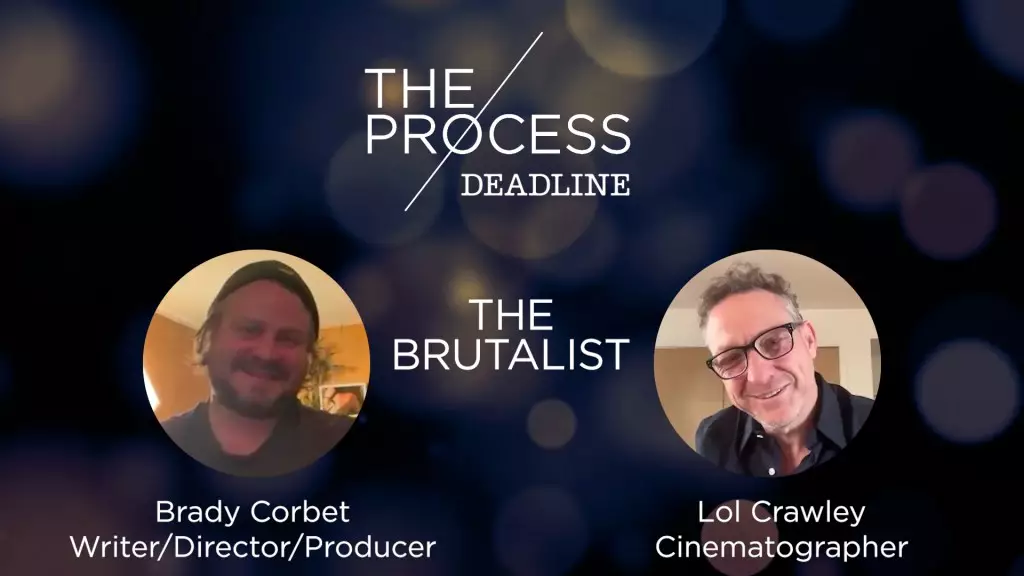In the expansive realm of modern cinema, the partnership between director Brady Corbet and cinematographer Lol Crawley stands out as a compelling case of artistic synergy. Their collaboration, marked by previous ambitious undertakings like “Vox Lux” and “The Childhood of a Leader,” reflects both a shared vision and a mutual understanding of cinematic storytelling. In their recent conversation featured in Deadline’s video series “The Process,” Corbet articulated the essence of their working relationship, emphasizing how their efforts, while met with mixed reactions, have always strived to push the boundaries of narrative and visuals.
Corbet describes the genesis of his screenwriting as a deeply personal experience, often confined and character-centric. He metaphorically depicts the initial scope of his films as a restricted circle, where the nuance of each character’s journey takes precedence over grandiosity. However, as the production transitions from script to screen, that limited vision expands dramatically, embodying a wider world that becomes possible through collective collaboration. His newfound faith in this collaborative process alleviates earlier anxieties regarding the film’s grandiosity, recognizing that it is the contributions of various individuals—from the heads of departments to everyday crew members—that truly shape cinematic experiences.
Cinematographer Lol Crawley gives insight into their collective ethos, asserting that discussions around the film often invoke a language imbued with cinematic potential. He points out that the ambition underscoring “The Brutalist” manifests not in shallow spectacle but in thoughtfully composed shots that serve the film’s characters and narrative. Crawley skillfully highlights that it is the fusion of the spatial dynamics and the performances—the interplay between the environment and actor—that create a rich cinematic language. This notion posits that true ambition in film doesn’t solely rest on grand actions, but in the delicate subtleties of storytelling conveyed through visuals.
However, the grueling reality of filmmaking has its challenges. Corbet and Crawley humorously acknowledge the inherent tolls of the process. The hectic lifestyle during film shoots often leads to exhaustion and tension. Corbet’s candid admission about the restless nature of production reveals the complexities that lie behind the scenes—a chaotic whirlwind where emotions run high and fatigue weighs heavily. Crawley further notes that for outsiders, a film set might appear to be an endless cycle of unrelenting tasks devoid of wonder, illustrating the stark contrast between the experience of creation and the observer’s perspective.
Set against the backdrop of post-World War II, “The Brutalist” weaves the poignant story of László Tóth, portrayed by Adrien Brody. This Hungarian-Jewish architect embodies resilience after navigating the horrors of the Holocaust, eager to forge a new life in the U.S. while he anxiously awaits the arrival of his wife, Erzsébet, played by Felicity Jones, and their niece Zsófia. The narrative unfolds a complex tapestry of hope, as the characters grapple with their past traumas while aspiring to build a future.
What further elevates “The Brutalist” is its robust ensemble cast, including notable performances from Joe Alwyn, Stacy Martin, and Emma Laird. The film’s accolades, including a prestigious win for Best Motion Picture Drama at the Golden Globes, alongside an impressive haul of nominations for both the Oscars and BAFTAs, underscore its critical acclaim and the resonance of its message.
Brady Corbet’s recognition of filmmaking as a collective endeavor underscores not only the importance of each individual’s contributions but also the art of cinema itself. It is a medium defined by collaboration, where every element—from the cinematography to the delicate performances—culminates in a work that speaks to the complexity of the human experience. As filmmakers continue to explore ambitious narratives like “The Brutalist,” it serves as a testament to the potential for storytelling to capture the intricacies of life, reminding audiences of the resilience and ambition that lie at the heart of the cinematic world.


Leave a Reply